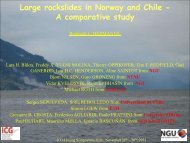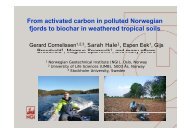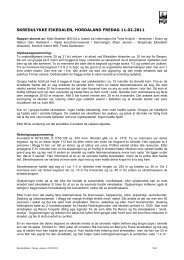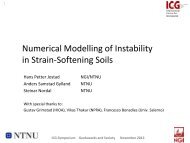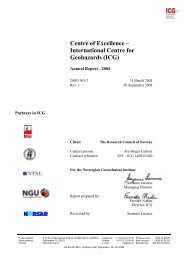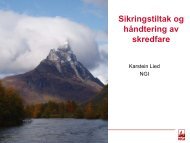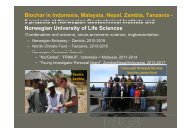Engineering monitoring of rockfall hazards along transportation ...
Engineering monitoring of rockfall hazards along transportation ...
Engineering monitoring of rockfall hazards along transportation ...
Create successful ePaper yourself
Turn your PDF publications into a flip-book with our unique Google optimized e-Paper software.
Nat. Hazards Earth Syst. Sci., 9, 935–946, 2009www.nat-<strong>hazards</strong>-earth-syst-sci.net/9/935/2009/© Author(s) 2009. This work is distributed underthe Creative Commons Attribution 3.0 License.Natural Hazardsand EarthSystem Sciences<strong>Engineering</strong> <strong>monitoring</strong> <strong>of</strong> <strong>rockfall</strong> <strong>hazards</strong> <strong>along</strong> <strong>transportation</strong>corridors: using mobile terrestrial LiDARM. Lato 1 , J. Hutchinson 1 , M. Diederichs 1 , D. Ball 2 , and R. Harrap 11 Geo<strong>Engineering</strong> Centre, Queen’s University at Kingston, On., Canada2 Geological Sciences and Geological <strong>Engineering</strong>, Queen’s University at Kingston, On., CanadaReceived: 2 December 2008 – Revised: 27 May 2009 – Accepted: 8 June 2009 – Published: 23 June 2009Abstract. Geotechnical <strong>hazards</strong> <strong>along</strong> linear <strong>transportation</strong>corridors are challenging to identify and <strong>of</strong>ten requireconstant <strong>monitoring</strong>. Inspecting corridors using traditional,manual methods requires the engineer to be unnecessarilyexposed to the hazard. It also requires closure <strong>of</strong> the corridorto ensure safety <strong>of</strong> the worker from passing vehicles.This paper identifies the use <strong>of</strong> mobile terrestrial LiDAR dataas a compliment to traditional field methods. Mobile terrestrialLiDAR is an emerging remote data collection techniquecapable <strong>of</strong> generating accurate fully three-dimensional virtualmodels while driving at speeds up to 100 km/h. Data iscollected from a truck that causes no delays to active trafficnor does it impede corridor use. These resultant georeferenceddata can be used for geomechanical structural featureidentification and kinematic analysis, <strong>rockfall</strong> path identificationand differential <strong>monitoring</strong> <strong>of</strong> rock movement or failureover time. Comparisons between mobile terrestrial andstatic LiDAR data collection and analysis are presented. Aswell, detailed discussions on workflow procedures for possibleimplementation are discussed. Future use <strong>of</strong> mobileterrestrial LiDAR data for corridor analysis will focus onrepeated surveys and developing dynamic four-dimensionalmodels, higher resolution data collection. As well, computationallyadvanced, spatially accurate, geomechanically controlledthree-dimensional <strong>rockfall</strong> simulations should be investigated.Correspondence to: M. Lato(mjlato@gmail.com)1 IntroductionGeotechnical <strong>hazards</strong>, especially <strong>rockfall</strong> related <strong>hazards</strong>,pose a significant concern to the management <strong>of</strong> <strong>transportation</strong>corridors (Maerz, 2000). Extensive rail and roadnetworks in regions <strong>of</strong> rugged terrain, such as the Alps, theSuperior Province <strong>of</strong> Canada, and the Canadian Cordillera,have complex relationships with their geological surroundings,and yet carry significant traffic. For operators <strong>of</strong> <strong>transportation</strong>corridors, the ability to identify potential <strong>hazards</strong>,assess geomechanics parameters <strong>along</strong>side the track /roadand measure movement, while maintaining safety for bothtraffic and workers, is paramount. This paper examines newtechniques for geomechanical evaluation <strong>along</strong> <strong>transportation</strong>corridors. Three site locations within Ontario, Canadawere used for the analyses: two sections <strong>of</strong> Provincial Highway15 near Ottawa, and a section <strong>of</strong> track <strong>along</strong> the AlgomaCentral Railway (ACR) in Northern Ontario.A typical hazard assessment flowchart for engineered<strong>monitoring</strong> <strong>of</strong> rockcuts and slopes is shown in Fig. 1. Variableson the left hand side illustrate hazard values that can bedirectly or indirectly determined. The flowchart assumes thatthe onsite or overseeing engineers are aware <strong>of</strong> potentiallyunstable and hazardous <strong>rockfall</strong> locations. This flowchartforms a foundation for in-the-field and in-<strong>of</strong>fice workflowsfor the assessment <strong>of</strong> <strong>hazards</strong> and thus forms a first-stepin planning hazard mitigation. We herein examine use <strong>of</strong>light detection and ranging – LiDAR, to help manage andassess <strong>rockfall</strong> <strong>hazards</strong> as a specific case in linear infrastructuremanagement; LiDAR represents a new approach to contributingto the geomechanical workflow.Traditionally, LiDAR units are statically mounted ontripods or deployed for mobile applications in helicoptersand airplanes. Aerial LiDAR employs similar scanning devicesto static equipment but are additionally equipped withPublished by Copernicus Publications on behalf <strong>of</strong> the European Geosciences Union.
936 M. Lato et al.: Using mobile terrestrial LiDAR for <strong>rockfall</strong> hazard analysisFig. 1. Engineered <strong>monitoring</strong> <strong>of</strong> rockcuts and slopes, specifically <strong>along</strong> railway corridors. Information measured, modeled, or calculatedare displayed as inputs on the left hand side. Probabilities are calculated based on discrete inputs.a global positioning system (GPS) and inertial navigationsystems (INS, also known as an inertial measurement unit– IMU) to determine location during flight (Yang and Farrell,2003). Through recent innovations, static LiDAR sensorshave been deployed in truck mounted mobile terrestrialapplications (Glennie, 2007a).Mobile terrestrial LiDAR is a breakthrough technology forthe field <strong>of</strong> geotechnical engineering that can be used effectivelywithin a <strong>rockfall</strong> hazard management system, LiDARdata, in the form <strong>of</strong> a point-cloud, can be collected for structurallyrelated geomechanical evaluation purposes at speeds<strong>of</strong> up to 30 km/h. At this rate, data can be quickly collectedfor large corridors <strong>of</strong> track or roadways. Employing mobileterrestrial LiDAR enables the rapid development <strong>of</strong> an accuratespatially inclusive LiDAR dataset for many geotechnicalstability issues. This LiDAR data can subsequently beused for accurate spatial identification <strong>of</strong> track features suchas rails, crossings, and signs as well as temporal differentialmodelling.The baseline dataset can be used to develop a 3-dimensional (3-D) model <strong>of</strong> the corridor. This computerbased geometric model will aid in developing GIS mapsand digital elevation models (DEM), the identification <strong>of</strong> potentialhazardous locations, and the ability to compare anddifferentiate the baseline data against subsequent temporalscans.The LiDAR-based model, in conjunction with active tracksupervision by engineers, provides a valuable <strong>rockfall</strong> evaluationtool (Turner, et al., 2006; Rosser et al., 2005). Theengineers currently <strong>monitoring</strong> the ACR, for example, usea customized <strong>rockfall</strong> hazard rating assessment system (Abbott,et al., 1998) based on field observations. This systemaids in categorizing and rating potential <strong>hazards</strong> based on geomechanics,track configuration, and slope properties. Identifyingzones <strong>along</strong> the track corridor that are perceived tobe hazardous either because <strong>of</strong> visible signs <strong>of</strong> failure or because<strong>of</strong> a high <strong>rockfall</strong> hazard rating as denoted by the assessment,further remote investigation can be completed usingthe baseline LiDAR dataset (Sturzenegger et al., 2007a).Nat. Hazards Earth Syst. Sci., 9, 935–946, 2009www.nat-<strong>hazards</strong>-earth-syst-sci.net/9/935/2009/
M. Lato et al.: Using mobile terrestrial LiDAR for <strong>rockfall</strong> hazard analysis 937Fig. 2. The TITAN system (silver box) is a multi-LiDAR scanner.Here is it shown mounted in the bed <strong>of</strong> a high-rail truck for deployment<strong>along</strong> the Algoma Central Railway.The information that can be extracted from LiDAR data includesdetailed geometry <strong>of</strong> the rock faces, track, ditches,other infrastructure, structural geological mapping and characterization,and evaluation <strong>of</strong> the vehicle operator’s line<strong>of</strong>-sight.Comparison <strong>of</strong> data from subsequent scans allowsevaluation <strong>of</strong> rock deformation and volumetric change. BaselineLiDAR data provides information which is required foran improved hazard management workflow: more efficient,repeatable, and reproducible.LiDAR data has been used for many geologically relatedacademic and industry projects over the last ten years. Theprojects have ranged from landslide detection (McKean andRoering, 2004) to debris flow modeling (Staley et al., 2005)and flood predictions (Mason et al., 2007).1.1 Mobile terrestrial LiDARMobile terrestrial LiDAR systems are comprised <strong>of</strong> a vehicle,a network <strong>of</strong> LiDAR sensors, a carrier-phase differentialGPS network, and an inertial navigation system (INS). TheGPS network employed for this operation consisted <strong>of</strong> oneonboard receiver, one static receiver located in the centre <strong>of</strong>the scanning area (a maximum distance <strong>of</strong> 10 km from theTITAN truck), and two static receivers located over federallyestablished benchmarks. The result <strong>of</strong> a scan from such asystem is a cloud <strong>of</strong> 3-D positions, reported in a geographiccoordinate system. This point cloud has several importantcharacteristics:– Points are limited to features visible from the perspective<strong>of</strong> the scanner (it is a line-<strong>of</strong>-sight technology).– Point density decreases as distance from the scanner increases;the sensor has a maximum range <strong>of</strong> 200 m.Fig. 3. LiDAR data collected by the TITAN system. Note for scalethe rockmass present in the right-hand side <strong>of</strong> the cloud is roughly5 m tall. This data was collected near Ottawa, Ontario, June 2007.– Points are collected at a high rate (TITAN, collects at40 000 pts/s).– The strength <strong>of</strong> the return is measured and reported asan intensity value, which allows genuine visual discrimination<strong>of</strong> different materials.The mobile terrestrial scanner used for this specific applicationwas TITAN, developed by Terrapoint, a division <strong>of</strong>Ambercore (Glennie, 2007a). The TITAN system (as shownin Fig. 2) is mounted on a pickup truck. A truck capable<strong>of</strong> traveling on a rail track was used for scanning <strong>along</strong> theACR. The silver pod elevated above the bed <strong>of</strong> the truck containsfour independent, uniquely oriented LiDAR scanningunits, one global positioning system (GPS) antenna, and oneINS system. The elevation <strong>of</strong> the pod is controlled fromwithin the operator’s cabin by a hydraulic lift. Other mobileterrestrial LiDAR systems include the Lynx (Optech, 2008)and active research projects by Alshawa et al. (2007).A typical LiDAR point cloud generated from the TITANmobile system is displayed in Fig. 3. While this appears tobe a grey-scale photograph, it is actually a view <strong>of</strong> tens <strong>of</strong>millions <strong>of</strong> 3-D points surveyed across a rockmass face andhighway surface. Recorded intensity values allow visible discrimination<strong>of</strong> painted lines on the road surface due to thematerials reflective properties.Regardless <strong>of</strong> the sensor technology, in a mobile scanningconfiguration, the position <strong>of</strong> the scanner at the instant <strong>of</strong>scanning must be known. This is accomplished by couplinga GPS receiver and an INS. GPS receivers accurately determinetheir position by time-<strong>of</strong>-flight determination to multiplesatellites from a roving field sensor (El-Rabbany, 2006).For precise mobile terrestrial applications, carrier phase GPSis used, which enables sub 5 cm positioning. It is essentialbecause the final positional accuracy <strong>of</strong> scan points relies onboth scanner precision and the accuracy <strong>of</strong> the scanner podposition.www.nat-<strong>hazards</strong>-earth-syst-sci.net/9/935/2009/ Nat. Hazards Earth Syst. Sci., 9, 935–946, 2009
938 M. Lato et al.: Using mobile terrestrial LiDAR for <strong>rockfall</strong> hazard analysisFig. 4. Differential GPS data collection as employed by the TITANsystem. The system is comprised <strong>of</strong> a network <strong>of</strong> satellites andground receivers.Fig. 5. GPS – INS – LIDAR sensors work in concert to produceglobally registered and locally accurate point clouds.Due to the vibration and movement <strong>of</strong> the vehicle, complexmovements <strong>of</strong> millimetres and centimetres per secondare superimposed on the overall vehicle path. As a result, asimple interpolation between GPS positions (collected onceper second) is inadequate for properly positioning each Li-DAR data point. An INS, consisting <strong>of</strong> coupled gyroscopesand accelerometers, is used to solve this problem, and, in addition,the INS also provides path reconstruction during shortintervals when GPS is unavailable due to obstructed views <strong>of</strong>the sky (Yang and Farrell, 2006). Importantly, the presence<strong>of</strong> an INS means that TITAN is capable <strong>of</strong> scanning shorttunnels and underpasses or canyons without loss <strong>of</strong> precision.The relative roles <strong>of</strong> GPS and INS are illustrated inFigs. 4 and 5.Globally referenced LiDAR data inherently has two associatedaccuracy values, commonly known as local and globalaccuracy. Local accuracy is primarily a factor <strong>of</strong> sensor error– which is the observed error <strong>of</strong> the LiDAR sensor itself.For TITAN data, this error is roughly 1 cm per 100 mdistance between the object and the sensor. Global accuracyis dependent on the GPS-INS solution as well as theLiDAR sensor error, and is a measure <strong>of</strong> how well the determinedlocations <strong>of</strong> 3-D points match their true geographiclocations. Global accuracy decreases as the distance fromthe differential GPS base station increases, at a maximumrate <strong>of</strong> 0.5 cm per 1 km with an initial error <strong>of</strong> 5 mm; thisis calculated at 0.5 cm+5 ppm (Glennie, 2007b). A generalbut thorough overview <strong>of</strong> accuracy considerations for mobileterrestrial mapping was conducted and published by Barberet al. (2008). Global accuracy does not affect the viewabilityor the analysis <strong>of</strong> the data, only the relation <strong>of</strong> theidentified features to their true locations in space, and so toother GIS datasets. It is essential for the geotechnical use <strong>of</strong>this data that the data collection errors be minimized. If thedata are going to be used for orientation-based measurementsthe errors will propagate through subsequent analyses as discussedby Buckley et al. (2008).1.2 Mobile terrestrial LiDAR data and static dataConventionally, LiDAR data is collected from static platformssuch as tripods or from mobile aerial vehicles. Datadensities range from 10 000 pts/m 2 for static systems anddown to 10 pts/m 2 for aerial systems. TITAN employs staticscanning technology (via Riegl sensors) on a mobile (truck)platform. The resultant data densities practically range from50 to 500 pts/m 2 (depending on velocity). Figure 6 illustratesa direct comparison <strong>of</strong> data collected with a static LeicaHDS 6000 system and the TITAN system. The LeicaHDS 6000 collects up to 500 000 pts/s at a density <strong>of</strong> up to10 000 pts/m 2 . Figure 6 also illustrates the cross-sectionalcontinuity <strong>of</strong> the datasets and the ability to combine datafrom separate scans to increase viewability while minimizingocclusion, which are zones <strong>of</strong> no data due to obstruction.Figure 6 illustrates that the data collected by the TITANsystem displays slightly greater local noise in comparison tothe Leica data; as well it is more challenging to visualizedue to the reduced point density. However, it is sufficient toperform accurate geomechanical structural analyses as willbe demonstrated below. Data are processed using PolyWorks(InnovMetric, 2008).1.3 Feature extraction and inventory from LiDAR dataSpatially accurate LiDAR data can be used to semiautomaticallymeasure physical features typically measuredby hand in the field. From a geotechnical perspective, measurementsthat can be rapidly acquired from LiDAR data include:slope angle and geometry, ditch height, width, andangle, and track geometry parameters such as curvature. Aswell, geomechanical structural data can be assessed in termsNat. Hazards Earth Syst. Sci., 9, 935–946, 2009www.nat-<strong>hazards</strong>-earth-syst-sci.net/9/935/2009/
M. Lato et al.: Using mobile terrestrial LiDAR for <strong>rockfall</strong> hazard analysis 939Fig. 6. (a) TITAN data collected in Ottawa, Ontario, June 2007,for an outcrop <strong>of</strong> well-fractured granite (b) illustrates the same outcropscanned with a Leica HDS 6000. (c) and (d) illustrate a crosssection<strong>of</strong> the collected data from (a) and (b) respectfully.<strong>of</strong> discontinuity surface orientation and spacing (Feng andRosh<strong>of</strong>f, 2004). The advantage <strong>of</strong> extracting these featuresfrom LiDAR data is that locations <strong>of</strong> measured features areautomatically generated because the data has inherent spatialattributes, there is increased precision <strong>of</strong> the measurements,direct digital storage, and there is the ability to reviewmeasurements. As well, the collection <strong>of</strong> this data doesnot involve the closure or obstruction <strong>of</strong> the track due toengineering personnel being present on the track; instead thedata is quickly collected from a mobile platform and processed<strong>of</strong>f-site – which increases the safety <strong>of</strong> the engineeras a result.2 Algoma railway LiDAR projectThe specific field test <strong>of</strong> the use <strong>of</strong> TITAN for geomechanicalevaluation was carried out <strong>along</strong> the Algoma Central Railway,with the collaboration <strong>of</strong> CN Rail, Transport Canada,Terrapoint and Queen’s University.2.1 Project backgroundThe Algoma Central Railway (ACR) was commissioned forconstruction in early 1899 and is currently owned and operatedby Canadian National Railway (CN). It is currently usedfor industrial (logging) and <strong>transportation</strong>/tourism purposes.The ACR is 475 km long and extends from Sault Ste. Marie,Fig. 7. Helicopter and TITAN LiDAR data were collected <strong>along</strong> theAlgoma Central Railway in July 2007 and June 2008 respectively.Ontario to Hearst, Ontario. The ACR runs <strong>along</strong> the banks<strong>of</strong> the Algoma River, the course <strong>of</strong> which is controlled bya Northeast-Southwest trending strike slip fault. The valleyridges range in elevation up to 900 m above the track level.Blasting and excavation techniques employed in constructionin the early 1900’s were much less sophisticated thanmodern methods. The combination <strong>of</strong> primitive blasting with100 years <strong>of</strong> weathering and track operation has resulted innumerous sites that pose significant <strong>rockfall</strong> <strong>hazards</strong> to passingtrains and their riders. CN, with the assistance <strong>of</strong> BruceGeotechnical Consultants (BGC), have mapped and evaluatedall potential hazard locations <strong>along</strong> the ACR accordingto methods developed by BGC (Pritchard et al., 2005).The result <strong>of</strong> the mapping project is a Rockfall Hazard RatingAssessment (RHRA) value for each location identifiedas potentially hazardous. The main challenge <strong>of</strong> this systemis the ability <strong>of</strong> the engineer to accurately measure variablessuch as slope height, angle, and pr<strong>of</strong>ile without being able tophysically climb the face. As well, measurements pertainingto the rockmass itself (structure orientation) are <strong>of</strong>ten generalizedbased on a random sampling <strong>of</strong> a few visible features.Figure 7 illustrates a section <strong>of</strong> the ACR that was mapped usingthe BGC methodology and displays the assessed RHRAvalues. This section <strong>of</strong> track was subsequently scanned withTITAN and helicopter LiDAR systems. As a result <strong>of</strong> thewww.nat-<strong>hazards</strong>-earth-syst-sci.net/9/935/2009/ Nat. Hazards Earth Syst. Sci., 9, 935–946, 2009
940 M. Lato et al.: Using mobile terrestrial LiDAR for <strong>rockfall</strong> hazard analysisFig. 8. Manual identification <strong>of</strong> structural features in LiDAR data using PolyWorks. These stereonets show a comparison between mappingusing high resolution Leica HDS 6000 data and lower-resolution TITAN data. Results indicate a strong agreement between the data sets.multiple LiDAR datasets and detailed human mapping andanalysis, this section <strong>of</strong> track is an excellent case history siteto assess how LiDAR can augment the data collected by askilled engineer.The scanning <strong>of</strong> the ACR with TITAN was an innovativeuse <strong>of</strong> both a high-rail truck (a truck designed to drive on railtracks) and mobile terrestrial LiDAR equipment. The datacollection did not impede or disrupt scheduled traffic <strong>along</strong>the ACR. The TITAN data were collected <strong>along</strong> the 20 kmstretch <strong>of</strong> the ACR illustrated in Fig. 7. The total collectiontime was 5 h, including 3.5 h for deployment.The rate <strong>of</strong> LiDAR data collection from TITAN is40 000 pts/s – a measure that is independent <strong>of</strong> truck speed.In order to produce data <strong>of</strong> sufficient density to extract discretegeological features, sections <strong>of</strong> track known to be <strong>of</strong>high <strong>rockfall</strong> hazard potential, based on ratings determinedusing the BGC system, were driven at a slower speed thanthe non-hazardous locations <strong>along</strong> the ACR.The most significant operational issue encountered whileplanning and collecting the data was quality <strong>of</strong> GPS signals.Due to the location <strong>of</strong> the ACR within a canyon, sky visibilityis typically poor. Using high sampling and high precisionINS alleviated this limitation. The global accuracy <strong>of</strong> theTITAN data collected <strong>along</strong> the ACR is ±15 cm and the localaccuracy <strong>of</strong> the data for any given section is approximately±3 cm. Following collection, data was delivered in a timestamped globally referenced X, Y, Z, I point-cloud format.The file size is 15 Gb.3 Mobile terrestrial feature extractionMobile terrestrial LiDAR data collected by TITAN can beused to measure features such as joints and fractures. However,before the measurements can be used for engineeringevaluation and design, the accuracy <strong>of</strong> the extracted featuresmust be assessed. In order to achieve this, a reference roadcut(in the Ottawa area) was scanned using both the TITAN andthe Leica HDS 6000 LiDAR systems. The results <strong>of</strong> thisevaluation are illustrated in Fig. 8. Previous work by Lato etal. (2009) has demonstrated that the use <strong>of</strong> data generated bystatic LiDAR equipment is viable for geomechanical evaluation<strong>of</strong> structural features. The data were evaluated usingDips (RocScience, 2006), a stereographic projection analysistool. As can be seen in Fig. 8, the data from mobile andstatic sources is compatible.The processing workflow for structural features measuredfrom both the TITAN data and the Leica HDS 6000 werecompleted using PolyWorks s<strong>of</strong>tware, a state-<strong>of</strong>-the-art Li-DAR processing tool. All planes were identified in thesame manual manner to avoid user bias as recommended bySturzenegger et al. (2007b). The extraction time per featureis roughly 20 s, allowing an individual <strong>rockfall</strong> zone to bestructurally evaluated in roughly 15–20 min. To facilitatethis process a macro was written in PolyWorks to automatethe creation <strong>of</strong> a plane based on selected points by the userthat visually lie on the same structural surface. The minimumarea <strong>of</strong> a joint detectable is dependent on the density <strong>of</strong>the LiDAR data. As data density increases, smaller featuresbecome apparent and their orientations can be extracted. Thedensity <strong>of</strong> the TITAN data in regions <strong>of</strong> interest <strong>along</strong> theACR is roughly 500 pts/m 2 and the minimum discontinuitysize detectable is thus roughly 20 cm×20 cm. The ability toidentify a discontinuity surface depends on both its size andorientation with respect to the scanning equipment. As theangle between the scanner and the surface increases toward90 ◦ the feature is occluded from the point cloud. There arecurrently no mathematical solutions to resolve this issue, socare is taken with evaluation <strong>of</strong> the LiDAR data and timeshould be reserved to explore the data to look for structuresat suspect orientations.Once the LiDAR data has been evaluated for structural features,the orientation <strong>of</strong> the measured surface is convertedNat. Hazards Earth Syst. Sci., 9, 935–946, 2009www.nat-<strong>hazards</strong>-earth-syst-sci.net/9/935/2009/
M. Lato et al.: Using mobile terrestrial LiDAR for <strong>rockfall</strong> hazard analysis 941Fig. 10. Stereonet illustrating the geomechanical features extractedfrom TITAN data collected near mile 94 <strong>of</strong> the Algoma CentralRailway. The rock face dips between 70 ◦ to slightly overhanging(in this image and subsequent images it is illustrated at 70 ◦ ).Fig. 9. Geomechanical feature identification and plane extraction <strong>of</strong>TITAN data collected <strong>along</strong> the Algoma Central Railway. Callouttabs represent each identified planar feature identified in the selectedsegment <strong>of</strong> track.from geographic i, j, k unit vectors (vectors representingthe surface oriented with respect to a global coordinate system)to dip and dip direction. This process is automaticallyconducted using a macro in MS Excel. The generated orientationsare then analyzed using Dips. Herein joint sets can beidentified, orientations can be evaluated, and potential failuremodes can be determined.3.1 Mile 94: test site workflowMile 94 on the ACR was identified using the BGC RHRAevaluation system as a high hazard zone. As shown in Fig. 9,the rockmass is near vertical, parallel to the track and rangesin height from 10–15 m above track level. The slope faceranges from an angle <strong>of</strong> 70 ◦ to slightly overhanging. A detailedstructural evaluation was completed using PolyWorksto determine the orientation <strong>of</strong> all visible planar discontinuitiesas scanned by TITAN. 52 joint surfaces were identified,measured and evaluated using the method described above.The structural features identified in Fig. 9, were convertedto dip and dip direction and analyzed in Dips. Joint sets andmean orientations were identified as illustrated in Fig. 10.As determined by visual inspection and using Dips, there arethree main joint sets present in this rockcut.Upon completion <strong>of</strong> the structural data extraction and evaluationbased on track location and orientation with respect tothe outcrop the rockcut can be evaluated for potential kinematicfailure modes. Along the evaluated section <strong>of</strong> Mile 94the rockmass is prone to both toppling and wedge failuremodes, as illustrated in Fig. 11.Toppling failure occurs when the dip <strong>of</strong> a joint exceedsthe angle <strong>of</strong> the slope <strong>of</strong> the face by the friction angle <strong>of</strong> therockmass (Goodman, 1980). The strike <strong>of</strong> the joint must bewithin 30 ◦ <strong>of</strong> parallel to the strike <strong>of</strong> the roadcut, as illustratedby the identified zone Fig. 11. Wedge failure is formedby the intersection <strong>of</strong> two independent planes that create asurface for a block(s) to slide on (Goodman, 1980). The intersection<strong>of</strong> the two planes forms a line that must dip steeperthan the friction angle <strong>of</strong> the rockmass and less steep than theslope <strong>of</strong> the rockcut in order for kinematic failure to be possible,as illustrated by the identified zone in Fig. 11.The ability to structurally map outcrop discontinuities usingmobile terrestrial LiDAR data is an improvement ingeomechanical evaluation technologies. The use <strong>of</strong> suchdata collection methodologies to enhance current geotechnicalevaluation workflows will significantly reduce traditionalfield based evaluations, and hence reduce track delays andexposure <strong>of</strong> track engineers to the risk <strong>of</strong> evaluating hazardousrockcuts in the field. We now examine the use <strong>of</strong> mobileterrestrial LiDAR data in combination with other LiDARdata sources for more advanced applications. The RHRA focusesefforts into identifying high-risk areas. LiDAR datacan be used to evaluate the identified areas where detailedkinematic and temporal analysis is required.www.nat-<strong>hazards</strong>-earth-syst-sci.net/9/935/2009/ Nat. Hazards Earth Syst. Sci., 9, 935–946, 2009
942 M. Lato et al.: Using mobile terrestrial LiDAR for <strong>rockfall</strong> hazard analysisFig. 11. Kinematic identification <strong>of</strong> possible <strong>rockfall</strong> failure modes present near mile 94 <strong>along</strong> the Algoma Central Railway. Topple andwedge failures are both identified as possible modes based on the LiDAR data analysis.4.1 Airborne and TITAN data: the ACR experiment,June 2008Fig. 12. Histogram illustrating the alignment comparison <strong>of</strong> TITANdata with helicopter data. The inset figure illustrates the alignment<strong>of</strong> the helicopter data (shown in black) with the titan data (shownin white). As well, illustrated in the inset figure is the general lack<strong>of</strong> helicopter data collected <strong>along</strong> the vertical rockface, due to thelook-angle <strong>of</strong> the airborne laser. The two data sets are not manuallyaligned, rather they are simply viewed in a common space based ontheir individually collected geographic coordinate information.4 Data fusionTITAN data provides data ranging from track level to roughly30 m beyond the track. Although the maximum scanning distance<strong>of</strong> TITAN is 200 m, <strong>along</strong> the ACR there is a denseBoreal forest and numerous outcrops that limit the visibility<strong>of</strong> TITAN from the track outwards. There were however noinstances where known track-side <strong>hazards</strong> were occluded inthe TITAN dataset.The ability to align and fuse TITAN data with other datasources will allow larger areas to be collected via airbornemethodologies or detailed studies to be completed with highresolutionstatic systems.Aside from using TITAN <strong>along</strong> the ACR track, a “low-range”LiDAR system mounted on a helicopter was deployed togenerate a valley scale LiDAR model. The low-range airborneLiDAR systems data were collected between 200–300 m above ground level. Low-range helicopter systemsare designed to collect relatively dense data in comparisonto fixed-wing aerial systems. This was completed during thesummer <strong>of</strong> 2007, 12 months before the scanning <strong>of</strong> the ACRusing the TITAN system. The resultant point-cloud producedby the helicopter system contains roughly 10 pts/m 2 . The airbornedata were reported in two formats: un-edited and bareearth.A “bare earth” model consists <strong>of</strong> the points that aredetermined to lie directly on the earth’s surface. Points representingtrees, shrubs, and infrastructure, for example, areremoved from the data set.Fusion <strong>of</strong> the TITAN and Airborne bare earth data wasachieved with the 3-D functionality <strong>of</strong> ArcGIS (ESRI, 2008).There was no adjustment <strong>of</strong> either dataset; they were simplyaligned and merged based on their independently collectedlocation information. For computing efficiency, only 1/12 <strong>of</strong>the data generated by TITAN were used for modelling completedin ArcGIS.To determine the correlation between the TITAN and airbornedata sets, an ArcGIS TIN model was built from thebare earth airborne data. Using the ArcGIS spot elevationfunction, the elevation on this TIN model at each TI-TAN point location was determined and then subtractedfrom the actual elevation recorded by the TITAN equipment.This operation was performed for a 1 m wide, 1 km longstrip that roughly followed the centerline <strong>of</strong> the track. Theresults, illustrated by Fig. 12, show a good match betweenthe datasets, with a distribution <strong>of</strong> height differences centredabout a point about 1 cm below the airborne data (median=−0.133 m). The small bump around the 0.3 m division representsthe ability <strong>of</strong> TITAN to accurately collect data fromNat. Hazards Earth Syst. Sci., 9, 935–946, 2009www.nat-<strong>hazards</strong>-earth-syst-sci.net/9/935/2009/
M. Lato et al.: Using mobile terrestrial LiDAR for <strong>rockfall</strong> hazard analysis 943Fig. 13. (a) Raw TITAN data and raw airborne data collected <strong>along</strong>the ACR, the data is viewed in a common geographic space. (b)Raw TITAN data extracted from the combined model in Fig. 13a.the surface <strong>of</strong> the rails <strong>along</strong> the track surface. 91% <strong>of</strong> thedata lie within ±10 cm and 96% within ±15 cm. The curvealso shows a long positive tail likely caused by vegetation onthe track and overhanging vegetation caught by the sidewaysand upward looking TITAN sensors. Once it was determinedthat the two datasets agreed vertically, they were merged intoa single file. Vegetation was removed from the TITAN databy filtering any TITAN points that were more that 0.15 mabove the bare-earth airborne data. A 7 m wide strip runningparallel to the railway centerline was defined and the airbornedata within this strip was replaced by the filtered TITAN data(Fig. 13).This process was completed to establish that althoughthe data were collected by different equipment, at differenttimes, using different GPS-INS solutions, the data could beintegrated for engineering purposes.4.2 Fusing TITAN and static dataA segment <strong>of</strong> data collected by TITAN near Ottawa, Ontariowas used to evaluate the fusion <strong>of</strong> high-resolution static datawith TITAN data. The static data were not collected withGPS so the cloud had no global spatial properties. The datasets were aligned in true space using visible points <strong>of</strong> commonalityand best-fit algorithms in the PolyWorks s<strong>of</strong>twarepackage, allowing the high-resolution data to assume true coordinatesbased on the information extracted from TITAN.Figure 14 illustrates the alignment. Error mapping was completedto assess the alignment and the datasets line up withan average error <strong>of</strong> ±3 cm. This is not a simple or logicalprocess because it involves the fusion <strong>of</strong> data collected atdifferent times, different resolutions, and most challengingly– using different data formats.Fig. 14. Fusion <strong>of</strong> high-resolution Leica HDS 6000 data with mobileTITAN data collected near Ottawa, Ontario – resulting in theproduction <strong>of</strong> a locally precise and globally accurate point cloud.4.2.1 Difference <strong>monitoring</strong>The ability to fuse high resolution LiDAR data with TITANallows the inherent qualities <strong>of</strong> the high-resolution data tobe exploited. One significant advantage <strong>of</strong> high-resolutiondata (up to 10 000 pts/m 2 ) over TITAN data (practically upto 500 pts/m 2 ) is the ability to conduct small scale differential<strong>monitoring</strong>. Differential <strong>monitoring</strong> requires successivescans to be completed evaluating the same area, effectivelygenerating a 4-dimensional model (Donovan and Raza,2008). Figure 15 illustrates an example <strong>of</strong> a rockcut that wasscanned at two intervals. The first scan is the baseline datathat will be used to evaluate successive scans for apparentmovement or rock block release. Before the second scan wascompleted small rock blocks were manually removed fromthe face (hence only apparent differentiation is observed inthe lower section <strong>of</strong> the outcrop, where rocks were safely accessibleby the scanning team). The coulour ramp indicatesdistance from the nearest neighbor – comparing one scan tothe next (grey indicates no apparent differential movement).The amount <strong>of</strong> differential movement observed in this exampleis between 3 and 15 cm. The main assumption made inthis analysis is that the tie-points used to align the successivescans are in the same position during both data collection periods.If the entire rock slope has moved tie-points locatedaway from the rock face should be used.These results conclude that differential <strong>monitoring</strong> usinghigh-resolution LiDAR can enable the detection <strong>of</strong> smallrock block release (sub 15 cm). This is an extremely valuabletool for <strong>monitoring</strong> progressive failure in a given rockmass.TITAN data can be used for temporal modelling as long asthe detectable movement is greater than the known combinedglobal and local errors. This enables, in a best-case scenario,detection <strong>of</strong> roughly 30–50 cm edge length blocks.www.nat-<strong>hazards</strong>-earth-syst-sci.net/9/935/2009/ Nat. Hazards Earth Syst. Sci., 9, 935–946, 2009
944 M. Lato et al.: Using mobile terrestrial LiDAR for <strong>rockfall</strong> hazard analysisFig. 15. Volumetric change detection by comparison <strong>of</strong> successive scans in time from a similar location. Identified zones represent between5 and 10 cm <strong>of</strong> movement or release <strong>of</strong> rock blocks.5 DiscussionThe examples illustrated in this paper outline the use <strong>of</strong> mobileterrestrial and static LiDAR in comparison to traditionalfieldwork completed by an experienced engineer. The dataused in these analyses were from three sources: airborne,mobile terrestrial – TITAN, and high-resolution static equipment– Leica HDS 6000. The examples described involvethe use <strong>of</strong> advanced technology, processing tools, and computationalpower. Through the use <strong>of</strong> these tools, many advantages<strong>of</strong> using LiDAR are readily identified.Other engineering applications <strong>of</strong> mobile terrestrial Li-DAR fused with airborne LiDAR are <strong>rockfall</strong> modelling andviewshed analyses. Rockfall models can be used to statisticallyevaluate potential <strong>rockfall</strong> paths and final positions.Traditional 2-D models are limited to a single possible pr<strong>of</strong>ile<strong>of</strong> movement. 3-D models enable direct interaction <strong>of</strong> thefalling rock with detailed topography, as illustrated by Lan etal. (2007).Viewshed analyses enable the visible distance to be calculatedfrom a known location, the potential visibility iscontrolled by topography. The quality <strong>of</strong> the topographicdata used for this analysis in terms <strong>of</strong> density, accuracy, andcoverage directly influence the result. The calculated visibilitycan be used to directly calculate stopping distances.As workflows develop that incorporate the use <strong>of</strong> LiDARdata, regardless <strong>of</strong> the source, it will be critical that automation<strong>of</strong> feature extraction evolve as well. There needs to bebetter integration with GIS and CAD based programs. Aswell, data visualization would greatly benefit from the abilityto colour the point cloud based on high-resolution photography.As the price <strong>of</strong> LiDAR data collection decreases, positioningsystems become more accurate, and processing tools becomeeasier to use, the incorporation <strong>of</strong> mobile terrestrialLiDAR scanning into active rail usage will be a part <strong>of</strong> thegeneral workflow. If trains are equipped with LiDAR scanners,real-time differential models could be generated as thetrain drives the rail line. This would generate a real-timehazard map identifying locations <strong>of</strong> mass-movement or therelease <strong>of</strong> rock blocks.The key to this work is not to speed up the operationalprocess <strong>of</strong> identifying <strong>hazards</strong> but to increase the safety,accuracy, and repeatability <strong>of</strong> their identification by usingnew state-<strong>of</strong>-the-art tools. For example geo-simulation toolssuch as Train-MAGS (Mekni et al., 2008) can be used toNat. Hazards Earth Syst. Sci., 9, 935–946, 2009www.nat-<strong>hazards</strong>-earth-syst-sci.net/9/935/2009/
M. Lato et al.: Using mobile terrestrial LiDAR for <strong>rockfall</strong> hazard analysis 945dynamically calculate maximum train speed based on stoppingdistance. The most powerful and useful advantages are:data fusion, feature extraction, differential <strong>monitoring</strong>, <strong>rockfall</strong>analysis, and viewshed analysis.6 ConclusionsThe ability to use LiDAR data to identify and examinegeomechanically controlled structural features has beendemonstrated and proven for many applications. However,the innovative use <strong>of</strong> mobile terrestrial LiDAR forsuch applications demonstrates significant advantages overtraditionally employed static terrestrial LiDAR includingcoverage, rate <strong>of</strong> acquisition, dynamic collection, and integrationwith corridor operation. Mobile terrestrial LiDAR isan evolving technology and the combination <strong>of</strong> tools availableto extract and analyze features within the data are alsoevolving. The examples in the paper and those being researchedby others will prove to be a cornerstone for a newdirection with respect to geomechanical feature identification,especially for sites in remote areas and those <strong>along</strong> active<strong>transportation</strong> corridors.Acknowledgements. The authors would like to thank TransportCanada, GEOIDE, NSERC, and the OCE for research funding.CN Rail provided track access and personnel during scanning.Edited by: M.-H. DerronReviewed by: S. Buckley and another anonymous refereeReferencesAbbott, B., Bruce, I., Keegan, T., Oboni, F., and, Savigny, W.: AMethodology for the Assessment <strong>of</strong> Rockfall Hazard and RiskAlong Linear Transportation Corridors, 8th Congress, InternationalAssoc. Of <strong>Engineering</strong> Geology, A Global View fromthe Pacific Rim, Vancouver: Balkema, A. A.,Vancouver, BritishColumbia, 2, 1195–1200, 1998.Alshawa, M., Smigiel, E., Grussenmeyer, P., and Landes, T.: Integration<strong>of</strong> a terrestrial LiDAR on a mobile mapping platform:first experiences, 5th International Symposium on Mobile MappingTechnology, Italy, p. 6, 2007.Barber, D., Mills, J., and Smith-Voysey, S.: Geometric validation<strong>of</strong> a ground-based mobile laser scanning system, Journal <strong>of</strong> Photogrammetryand Remote Sensing, 63, 128–141, 2008.Buckley, S. J., Howell, J. A., Enge, H. D., and Kurz, T. H.: Terrestriallaser scanning in geology: data acquisition, processing andaccuracy considerations, J. Geol. Soc. London, 165, 625–638,2008.Donovan, J. and Raza, A. W.: A change detection method for slope<strong>monitoring</strong> and identification <strong>of</strong> potential <strong>rockfall</strong> using threedimensionalimaging, San Francisco, American Rock MechanicsAssociation, X., 2008.El-Rabbany, A.: Norwood: Artech House Publishers, Introductionto GPS: The Global Positioning System., 2nd Edition , 2006.ESRI: ArcGIS V9.3 (Build 1770), Redlands, Ca. USA, 2008Feng, Q. and Rosh<strong>of</strong>f, K.: In situ mapping and documentation <strong>of</strong>rock fases using a full-coverage 3-D laser scanning technique,Paper 1A 23, CD-ROM, Int. J. Rock Mech. Min., 41(3), 379,2004.Glennie, C.: Reign <strong>of</strong> point clouds: a kinematic terrestrial LiDARscanning system, InsideGNSS, Fall 2007, 21–31, 2007a.Glennie, C.: Rigorous 3D error analysis <strong>of</strong> kinematic scanning Li-DAR systems, J. Appl. Geodesy, 1, 147–157, 2007b.Goodman, R. E.: Introduction to rock mechanicsm, edited by: Wiley,J., Toronto, Chapter 8, 1980.InnovMetric: PolyWorks V10.1, Quebec City, Qu., Canada, 2008.Lan, H., Martin, C. D., and Lim, C. H.: Rockfall Analyst: a GISextension for three-dimensional and spatially distributed <strong>rockfall</strong>hazard <strong>monitoring</strong>, Comput. Geosci., 33, 262–279, 2007.Lato, M., Hutchinson, D. J., Diederichs, M. S., and Harrap, R.:Optimization <strong>of</strong> LiDAR scanning and processing for automatedstructural evaluation <strong>of</strong> discontinuities in rockmasses, Int. J.Rock Mech. Min., 46, 194–199, 2009.Maerz, N. H.: Highway rock cut stability assessment in rockmassed not conducive to stability calculations, Proceedings <strong>of</strong>the 51st Annual Highway Geology Symposium, Seattle, Washington,249–259, 2000.Mason, D. C., Horritt, M. S., Hunter, N. M., and Bates, P. D.: Use<strong>of</strong> fused airborne scanning laser altimetry and digital map datafor urban flood modelling, Hydrol. Process., 21(11), 1436–1447,2007.McKean, J. and Roering, J.: Objective landlside detection and surfacemorphology mapping using high-resolustion airborne laseraltimetre, Geomorphology, 57, 331–351, 2004.Mekni, M., Sahli, N., and Moulin, B.: A geosimulation approachinvolving spatially-aware agents: A case study on the identification<strong>of</strong> risky areas for trains, SpringSim, 1-56555-319-5, 37–45,2008.Optech. Inc. , Lynx Mobile Mapper, Toronto, On. Canada 2008.Pritchard, M., Porter, M., Savigny, K. W., Bruce, I., Oboni, F.,Keegan, T., et al.: CN <strong>rockfall</strong> hazard risk management system:experience, enhancements, and future direction, The AmericanRailway <strong>Engineering</strong> and Maintenance-<strong>of</strong>-Way Association,Chicago, 2005.RocScience, Dips 5.1. Toronto, On. Canada, 2005.Rosser, N., Dunning, S., Lim, M., and Petley, D.: Terrestrial laserscanning for quantative <strong>rockfall</strong> hazard assessment, in: Landsliderisk management, edited by: Hunger, O., Fell, R., Couture, R.,Eberhardt, E., Rotterdam, Balkema, p. 091, 2005.Staley, D. M., Wasklewick, T. A., and Blaszcynski, J. S.: Surficialpatterns <strong>of</strong> debris flow deposition on alluvial fans in DeathValley, CA using airborne laser swath mapping data, Geomorphology,74(1–4), 152–163, 2005.Sturzenegger, M., Stead, D., Froese, C., Moreno, F., and Jaboyed<strong>of</strong>f,M.: Ground-based and airborne LiDAR for structural mapping<strong>of</strong> a large landslide: the Frank Slide, in: Proceedings <strong>of</strong> thefirst Canadian US rock mechanics symposium vol. 2, edited by:Eberhardt, E., Stead, D., and, Morrison, T., Vancouver, London,Taylor and Francis, 925–932, 2007a.Sturzenegger, M., Yan, M., Stead, D., and Elmo, D.: Applicationsand limitiations <strong>of</strong> ground-based laser scanning in rock slopecharacterization, in: Proceedings <strong>of</strong> the first Canadian US rockmechanics symposium vol. 1, edited by: Eberhardt, E., Stead, D.and, Morrison, T., London, Taylor and Francis, 29–36, 2007b.www.nat-<strong>hazards</strong>-earth-syst-sci.net/9/935/2009/ Nat. Hazards Earth Syst. Sci., 9, 935–946, 2009
946 M. Lato et al.: Using mobile terrestrial LiDAR for <strong>rockfall</strong> hazard analysisTurner, A. K., Kemeny, J., Slob, S., and Hack, R.: Evaluation andmanagement <strong>of</strong> unstable rock slopes by 3-D laser scanning, InternationAssociation for <strong>Engineering</strong> Geology and the Environmnet,paper no. 404, Geol. Soc. London, 1–11, 2006.Yang, Y. and Farrell, J. A.: Magnetometer and differential carrierphase GPS-aided INS for advanced vehicle control, IEEET. Robotic. Autom., 19(2), 269–282, 2003.Nat. Hazards Earth Syst. Sci., 9, 935–946, 2009www.nat-<strong>hazards</strong>-earth-syst-sci.net/9/935/2009/





